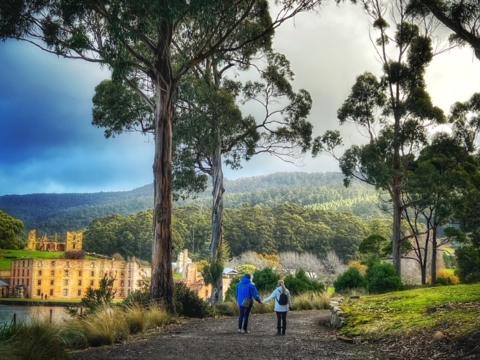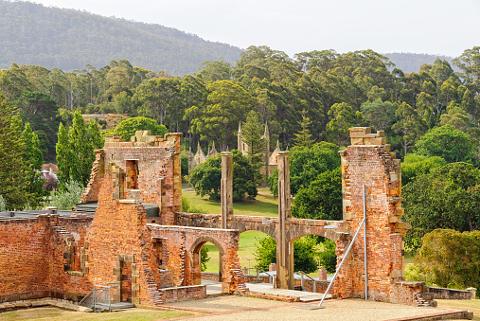





Hobart Convict Penitentiary
Historic Chapel and Prison
WHAT SPARKS YOUR INTEREST?
History
 Learn more about the convict history of Van Diemen’s land right in the heart of Hobart. The Hobart Convict Penitentiary, or as it was known by its inhabitants, the Tench, was built in the early 1830s to accommodate the growing number of convicts making their way into the colony. Designed by Civil Engineer John Lee Archer, over 50,000 male convicts had the misfortune of passing through these prisoners’ barracks. Once transportation of convicts had halted, the grounds were then used for other purposes such as Hobart’s Old Gaol (1857) and Supreme Court. Image thanks to Tourism Tasmania & Supplied Courtesy of National Trust Tasmania.
Learn more about the convict history of Van Diemen’s land right in the heart of Hobart. The Hobart Convict Penitentiary, or as it was known by its inhabitants, the Tench, was built in the early 1830s to accommodate the growing number of convicts making their way into the colony. Designed by Civil Engineer John Lee Archer, over 50,000 male convicts had the misfortune of passing through these prisoners’ barracks. Once transportation of convicts had halted, the grounds were then used for other purposes such as Hobart’s Old Gaol (1857) and Supreme Court. Image thanks to Tourism Tasmania & Supplied Courtesy of National Trust Tasmania.
 Enclosed by a high stone wall, the area originally covered a 2-acre block. In the shape of a cruciform, the complex included a chapel with 36 solitary confinement cells below its floor. The smallest of these cells were sealed up and deemed inhumane in 1847, as they had no light and were poorly ventilated. Image thanks to Tourism Tasmania & Supplied Courtesy of National Trust Tasmania.
Enclosed by a high stone wall, the area originally covered a 2-acre block. In the shape of a cruciform, the complex included a chapel with 36 solitary confinement cells below its floor. The smallest of these cells were sealed up and deemed inhumane in 1847, as they had no light and were poorly ventilated. Image thanks to Tourism Tasmania & Supplied Courtesy of National Trust Tasmania.
 Separate entrances to the chapel were constructed for the prisoners and free inhabitants. While the free inhabitants would enter via the northern wing on a tower staircase and could reserve cedar pews for an annual fee, the prisoners would arrive via different wings and install themselves on hard, wooden benches. The chapel was never consecrated as a church, but was in full use by late 1833, and the final fitting completed in the following year. The chapel hosted normal services, as well as ceremonies such as baptisms, funerals, and weddings. Image thanks to Tourism Tasmania & Supplied Courtesy of National Trust Tasmania.
Separate entrances to the chapel were constructed for the prisoners and free inhabitants. While the free inhabitants would enter via the northern wing on a tower staircase and could reserve cedar pews for an annual fee, the prisoners would arrive via different wings and install themselves on hard, wooden benches. The chapel was never consecrated as a church, but was in full use by late 1833, and the final fitting completed in the following year. The chapel hosted normal services, as well as ceremonies such as baptisms, funerals, and weddings. Image thanks to Tourism Tasmania & Supplied Courtesy of National Trust Tasmania.
Services were anything but peaceful. Complaints ensued regarding the disturbing noises from the solitary cells below, and ventilation was extremely poor. The chapel remained in use until 1845, and was reopened again in 1853 by the Rev. Mr. J. Medland.
In 1857 the Penitentiary was proclaimed a Gaol and House of Correction. Prisoners were moved here from the nearby Murray Street gaol. An execution yard was installed and the first hanging took place on 18 August 1857. A total of 32 prisoners lost their lives by this means until the last Tasmanian hanging in 1946.
In 1859 sections of the chapel were converted into two Supreme Criminal Courts connected by tunnels to the gaol. Significant renovations were made to construct the courts, with the western transept retained as a chapel in almost its original state. Weekly services took place there all the way until 1961. The court rooms were first used in 1860 and served various judicial purposes until 1983. Only minor alterations were made during this time, keeping most of the construction intact.
Getting there/Entry/Tours
 The Penitentiary is located at 6 Brisbane St, on the corner of Brisbane and Campbell Streets in Hobart. It is easily accessible by foot from downtown Hobart, or via the Red Decker Bus Stop “Old Hobart Gaol”.
The Penitentiary is located at 6 Brisbane St, on the corner of Brisbane and Campbell Streets in Hobart. It is easily accessible by foot from downtown Hobart, or via the Red Decker Bus Stop “Old Hobart Gaol”.It is open 7 days a week and can be accessed by guided tours or pre-arranged group bookings for a general admission fee. The National Trust Shop is available during opening hours. Image thanks to Tourism Tasmania & Supplied Courtesy of National Trust Tasmania.
Guided tours will lead visitors through the chapel, solitary cells, underground tunnels, and gallows. In addition to the daytime tours, there are several other immersive experiences including the Chapel Ghost Tour, The Hobart Gallows Walk, Paranormal Investigation, and “Pandemonium - The Convict Film Experience”.











































